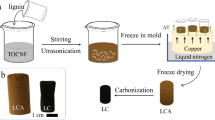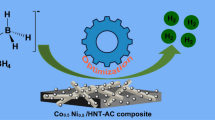Abstract
The porous 3D structure of zinc-doped carbon aerogel is created from cellulose precursor extracted from banana stem—a biomass waste that is abundant in Vietnam—through a simple and easy-to-implement 2-step process. Additionally, sodium alginate was used as a crosslinker and zinc acetate as a network coupling agent that can strengthen the gel system and increase the porosity of the carbon aerogel. In addition, zinc acetate also acts as a doping agent, increasing the ionic mobility of the material. Zinc-doped carbon aerogels synthesized from banana stem (Zn-BS-CA) have outstanding characteristics such as high specific surface area (up to 115 m2/g), diverse pore shapes, high porosity of the material, and low bulk specific gravity. Characterization of Zn-BS-CA was shown through modern methods (scanning electron microscope, Fourier transform infrared spectroscopy, Raman spectroscopy, X-ray crystallography, energy-dispersive X-ray, and nitrogen adsorption–desorption isotherms). Zn-BS-CA reached a maximum oil adsorption capacity of 34,997 g/g and a specific capacitance of 74 F/g for Zn-BS-CA pyrolyzed at 700 °C (Zn-BS-CA700). More importantly, Zn-BS-CA 700 shows capacity retention of 95% after over 500 cycles. The above results indicate high oil adsorption and energy storage capabilities of Zn-BS-CA.













Similar content being viewed by others
Data availability
All data generated or analyzed during this study are included in this article.
References
Nianyin L, Chao W, Suiwang Z et al (2021) Recent advances in waterless fracturing technology for the petroleum industry: an overview. J Nat Gas Sci Eng 92:103999. https://doi.org/10.1016/j.jngse.2021.103999
Chen SY, Zhang Q, Mclellan B, Zhang TT (2020) Review on the petroleum market in China: history, challenges and prospects. Pet Sci 17:1779–1794. https://doi.org/10.1007/s12182-020-00501-6
Adeleke BS, Babalola OO (2020) Oilseed crop sunflower (Helianthus annuus) as a source of food: nutritional and health benefits. Food Sci Nutr 8:4666–4684. https://doi.org/10.1002/fsn3.1783
Moroni D, Pieri G, Tampucci M (2019) Environmental decision support systems for monitoring small scale oil spills: existing solutions, best practices and current challenges. J Mar Sci Eng 7:. https://doi.org/10.3390/JMSE7010019
Phat LN, Thang TQ, Nguyen HC et al (2021) Fabrication and modification of cellulose aerogels from Vietnamese water hyacinth for oil adsorption application. Korean J Chem Eng 38:2247–2255. https://doi.org/10.1007/s11814-021-0853-x
Zou J, Chai W, Liu X, et al (2016) Magnetic pomelo peel as a new absorption material for oil-polluted water. 3994:. https://doi.org/10.1080/19443994.2015.1049958
Yang J, Teng J, Dou M et al (2021) Technical application of waste oil treatment in compound field. IOP Conf Series: Earth Environ Sci 1011:. https://doi.org/10.1088/1755-1315/1011/1/012032
Yu Q, Tian F, Cao Y et al (2021) Application of waste engine oil for improving ilmenite flotation combined with sodium oleate collector. Minerals 11:. https://doi.org/10.3390/min11111242
Akhayere E, Kavaz D, Vaseashta A (2022) Efficacy studies of silica nanoparticles synthesized using agricultural waste for mitigating waterborne contaminants. Applied Sciences (Switzerland) 12:1–19. https://doi.org/10.3390/app12189279
Imparato C, Bifulco A, Silvestri B, Vitiello G (2022) Recent advances in endocrine disrupting compounds degradation through metal oxide-based nanomaterials
Ray SK, Truong HB, Arshad Z et al (2020) Recent advances in the characterization and the treatment methods of effluent organic matter. Membrane Water Treat 11:257–274. https://doi.org/10.12989/mwt.2020.11.4.257
Phat LN, Tu PM, Lin TH et al (2022) PDMS – coated pomelo peel carbon aerogel: Synthesis, characterization, and oil removal application. Vietnam J Chem 60:14–20. https://doi.org/10.1002/vjch.202200040
Minh TuP, Nam Phat L, Hoang Lin T et al (2022) Effects of activation conditions on the characteristics, adsorption capacity, and energy storage of carbon aerogel from watermelon rind. ChemNanoMat. https://doi.org/10.1002/cnma.202200426
Xu Z, Zhou H, Tan S et al (2018) Ultralight super-hydrophobic carbon aerogels based on cellulose nanofibers/poly(vinyl alcohol)/graphene oxide (CNFs/PVA/GO) for highly effective oil-water separation. Beilstein J Nanotechnol 9:508–519. https://doi.org/10.3762/bjnano.9.49
Long S, Feng Y, He F et al (2021) Biomass-derived, multifunctional and wave-layered carbon aerogels toward wearable pressure sensors, supercapacitors and triboelectric nanogenerators. Nano Energy 85:105973. https://doi.org/10.1016/j.nanoen.2021.105973
Esposito S (2019) “Traditional” sol-gel chemistry as a powerful tool for the preparation of supported metal and metal oxide catalysts. Materials 12:1–25. https://doi.org/10.3390/ma12040668
Zhang H, Cheng J, Ao Q (2021) Preparation of alginate-based biomaterials and their applications in biomedicine. Mar Drugs 19:1–24. https://doi.org/10.3390/md19050264
Rizwan M, Rubina Gilani S, Iqbal Durani A, Naseem S (2021) Materials diversity of hydrogel: synthesis, polymerization process and soil conditioning properties in agricultural field. J Adv Res 33:15–40. https://doi.org/10.1016/j.jare.2021.03.007
Yu D, Zhang Z, Teng Y et al (2020) Controllable synthesis of cobalt molybdate nanoarrays on nickel foam as the advanced electrodes of alkaline battery-supercapacitor hybrid devices. J Alloys Compd 835:155244. https://doi.org/10.1016/j.jallcom.2020.155244
Xu Y, Li J, Huang W (2017) Porous graphene oxide prepared on nickel foam by electrophoretic deposition and thermal reduction as high-performance supercapacitor electrodes. Materials 10:. https://doi.org/10.3390/ma10080936
Liu M, Wu F, Zheng L et al (2021) Nature-inspired porous multichannel carbon monolith: molecular cooperative enables sustainable production and high-performance capacitive energy storage. InfoMat 3:1154–1170. https://doi.org/10.1002/inf2.12231
Parsimehr H, Ehsani A (2020) Algae-based electrochemical energy storage devices. Green Chem 22:8062–8096. https://doi.org/10.1039/d0gc02246b
Tock JY, Lai CL, Lee KT et al (2010) Banana biomass as potential renewable energy resource: a Malaysian case study. Renew Sustain Energy Rev 14:798–805. https://doi.org/10.1016/j.rser.2009.10.010
Schroeter B, Yonkova VP, Goslinska M et al (2021) Spray coating of cellulose aerogel particles in a miniaturized spouted bed. Cellulose 28:7795–7812. https://doi.org/10.1007/s10570-021-04032-0
Van NTT, Phan AN, Cuong VC, et al (2023) Enhanced heterogeneous Fenton degradation of <math altimg="si1.svg" display="inline" id="d1e467"> <mi>p</mi> </math> -nitrophenol by Fe <math altimg="si2.svg" display="inline" id="d1e472"> <msub> <mrow/> <mrow> <mn>3</mn> </mrow> </msub> </math> O <math altimg="si3.svg" display="inline" id="d1e480"> <msub> <mrow/> <mrow> <mn>4</mn> </mrow> </msub> </math> nanoparticles decorated cellulose aerogel from banana stem. Environ Technol Innov 30:103041. https://doi.org/10.1016/j.eti.2023.103041
Lee YJ, Jung JC, Park S et al (2010) Preparation and characterization of metal-doped carbon aerogel for supercapacitor. Curr Appl Phys 10:947–951. https://doi.org/10.1016/j.cap.2009.11.078
Ha NT, Van CL, Anh PV et al (2016) Research on oil adsorption capacity of carbonized material derived from agricultural by-product ( corn cob, corn stalk, rice husk ) using in oily wastewater treatment. Nat Sci Technol 32:105–111
Xu B, Wu F, Chen R et al (2008) Electrochemistry communications highly mesoporous and high surface area carbon : a high capacitance electrode material for EDLCs with various electrolytes. 10:795–797.https://doi.org/10.1016/j.elecom.2008.02.033
Lin CC, Li YY (2009) Synthesis of ZnO nanowires by thermal decomposition of zinc acetate dihydrate. Mater Chem Phys 113:334–337. https://doi.org/10.1016/j.matchemphys.2008.07.070
Vijayalakshmi U, Chellappa M, Anjaneyulu U et al (2016) Influence of coating parameter and sintering atmosphere on the corrosion resistance behavior of electrophoretically deposited composite coatings. Mater Manuf Processes 31:95–106. https://doi.org/10.1080/10426914.2015.1070424
Rodwihok C, Wongratanaphisan D, Ngo YLT et al (2019) Effect of GO additive in ZnO/rGO nanocomposites with enhanced photosensitivity and photocatalytic activity. Nanomaterials 9:. https://doi.org/10.3390/nano9101441
Garcia-Granda S, Montejo-Bernardo JM (2004) X-ray absorption and diffraction - X-ray diffraction - powder. Encycl Anal Sci: Second Edition 389–397. https://doi.org/10.1016/B0-12-369397-7/00671-3
Cychosz KA, Guo X, Fan W et al (2012) Characterization of the pore structure of three-dimensionally ordered mesoporous carbons using high resolution gas sorption. Langmuir 28:12647–12654. https://doi.org/10.1021/la302362h
Sun S, Yan Q, Wu M, Zhao X (2021) Carbon aerogel based materials for secondary batteries. Sustain Mater Technol 30:e00342. https://doi.org/10.1016/j.susmat.2021.e00342
de la Rosa JM, Rosado M, Paneque M et al (2018) Effects of aging under field conditions on biochar structure and composition: implications for biochar stability in soils. Sci Total Environ 613–614:969–976. https://doi.org/10.1016/j.scitotenv.2017.09.124
Lv N, Wang X, Peng S et al (2018) Study of the kinetics and equilibrium of the adsorption of oils onto hydrophobic jute fiber modified via the sol-gel method. Int J Environ Res Public Health 15:. https://doi.org/10.3390/ijerph15050969
Tobi AR, Dennis JO, Zaid HM (2021) Evaluation of low-cost high performance solid-state supercapacitor derived from physically and chemically activated oil palm fiber. Materials Letters 285:129127. https://doi.org/10.1016/j.matlet.2020.129127
Acknowledgements
We acknowledge Ho Chi Minh City University of Technology (HCMUT), VNU-HCM, for supporting this study.
Funding
We acknowledge Ho Chi Minh City University of Technology (HCMUT), VNU-HCM, for supporting this study.
Author information
Authors and Affiliations
Contributions
All authors contributed to the study conception. Material preparation, data collection, and analysis were performed by Phan Minh Tu, Le Thanh Ngan, Nguyen Hoang Kim Duyen, and Dang Ngoc Chau Vy. The first draft of the manuscript was written by Phan Minh Tu, Tran Quoc Thang, Cao Vu Lam, and Nguyen Huu Hieu, and all authors commented on previous versions of the manuscript. All authors read and approved the final manuscript.
Corresponding author
Ethics declarations
Ethical approval
This material is the authors’ own original work, which has not been previously published elsewhere.
Competing interests
The authors declare no competing interests.
Additional information
Publisher's note
Springer Nature remains neutral with regard to jurisdictional claims in published maps and institutional affiliations.
Supplementary Information
Below is the link to the electronic supplementary material.
Rights and permissions
Springer Nature or its licensor (e.g. a society or other partner) holds exclusive rights to this article under a publishing agreement with the author(s) or other rightsholder(s); author self-archiving of the accepted manuscript version of this article is solely governed by the terms of such publishing agreement and applicable law.
About this article
Cite this article
Tu, P.M., Vy, D.N.C., Ngan, L.T. et al. Superhydrophobic banana stem–derived carbon aerogel for oil and organic adsorptions and energy storage. Biomass Conv. Bioref. (2023). https://doi.org/10.1007/s13399-023-04176-y
Received:
Revised:
Accepted:
Published:
DOI: https://doi.org/10.1007/s13399-023-04176-y




